+ Open data
Open data
- Basic information
Basic information
| Entry | Database: PDB / ID: 7cr6 | ||||||
|---|---|---|---|---|---|---|---|
| Title | Synechocystis Cas1-Cas2/prespacer binary complex | ||||||
 Components Components |
| ||||||
 Keywords Keywords | IMMUNE SYSTEM/DNA / CRISPR / adaptation / IMMUNE SYSTEM / IMMUNE SYSTEM-DNA complex | ||||||
| Function / homology |  Function and homology information Function and homology informationCRISPR-cas system / maintenance of CRISPR repeat elements / RNA endonuclease activity / DNA endonuclease activity / endonuclease activity / defense response to virus / Hydrolases; Acting on ester bonds / hydrolase activity / DNA binding / metal ion binding Similarity search - Function | ||||||
| Biological species |  synthetic construct (others) | ||||||
| Method |  X-RAY DIFFRACTION / X-RAY DIFFRACTION /  SYNCHROTRON / SYNCHROTRON /  MOLECULAR REPLACEMENT / Resolution: 3.72 Å MOLECULAR REPLACEMENT / Resolution: 3.72 Å | ||||||
 Authors Authors | Yu, Y. / Chen, Q. | ||||||
 Citation Citation |  Journal: Nucleic Acids Res / Year: 2021 Journal: Nucleic Acids Res / Year: 2021Title: Mechanisms of spacer acquisition by sequential assembly of the adaptation module in Synechocystis. Authors: Chengyong Wu / Dongmei Tang / Jie Cheng / Daojun Hu / Zejing Yang / Xue Ma / Haihuai He / Shaohua Yao / Tian-Min Fu / Yamei Yu / Qiang Chen /   Abstract: CRISPR-Cas immune systems process and integrate short fragments of DNA from new invaders as spacers into the host CRISPR locus to establish molecular memory of prior infection, which is also known as ...CRISPR-Cas immune systems process and integrate short fragments of DNA from new invaders as spacers into the host CRISPR locus to establish molecular memory of prior infection, which is also known as adaptation in the field. Some CRISPR-Cas systems rely on Cas1 and Cas2 to complete the adaptation process, which has been characterized in a few systems. In contrast, many other CRISPR-Cas systems require an additional factor of Cas4 for efficient adaptation, the mechanism of which remains less understood. Here we present biochemical reconstitution of the Synechocystis sp. PCC6803 type I-D adaptation system, X-ray crystal structures of Cas1-Cas2-prespacer complexes, and negative stained electron microscopy structure of the Cas4-Cas1 complex. Cas4 and Cas2 compete with each other to interact with Cas1. In the absence of prespacer, Cas4 but not Cas2 assembles with Cas1 into a very stable complex for processing the prespacer. Strikingly, the Cas1-prespacer complex develops a higher binding affinity toward Cas2 to form the Cas1-Cas2-prespacer ternary complex for integration. Together, we show a two-step sequential assembly mechanism for the type I-D adaptation module of Synechocystis, in which Cas4-Cas1 and Cas1-Cas2 function as two exclusive complexes for prespacer processing, capture, and integration. | ||||||
| History |
|
- Structure visualization
Structure visualization
| Structure viewer | Molecule:  Molmil Molmil Jmol/JSmol Jmol/JSmol |
|---|
- Downloads & links
Downloads & links
- Download
Download
| PDBx/mmCIF format |  7cr6.cif.gz 7cr6.cif.gz | 697.3 KB | Display |  PDBx/mmCIF format PDBx/mmCIF format |
|---|---|---|---|---|
| PDB format |  pdb7cr6.ent.gz pdb7cr6.ent.gz | 468.5 KB | Display |  PDB format PDB format |
| PDBx/mmJSON format |  7cr6.json.gz 7cr6.json.gz | Tree view |  PDBx/mmJSON format PDBx/mmJSON format | |
| Others |  Other downloads Other downloads |
-Validation report
| Summary document |  7cr6_validation.pdf.gz 7cr6_validation.pdf.gz | 496.4 KB | Display |  wwPDB validaton report wwPDB validaton report |
|---|---|---|---|---|
| Full document |  7cr6_full_validation.pdf.gz 7cr6_full_validation.pdf.gz | 527.4 KB | Display | |
| Data in XML |  7cr6_validation.xml.gz 7cr6_validation.xml.gz | 54.2 KB | Display | |
| Data in CIF |  7cr6_validation.cif.gz 7cr6_validation.cif.gz | 73.3 KB | Display | |
| Arichive directory |  https://data.pdbj.org/pub/pdb/validation_reports/cr/7cr6 https://data.pdbj.org/pub/pdb/validation_reports/cr/7cr6 ftp://data.pdbj.org/pub/pdb/validation_reports/cr/7cr6 ftp://data.pdbj.org/pub/pdb/validation_reports/cr/7cr6 | HTTPS FTP |
-Related structure data
| Related structure data | 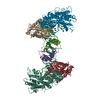 7cr8C  1zpwS S: Starting model for refinement C: citing same article ( |
|---|---|
| Similar structure data |
- Links
Links
- Assembly
Assembly
| Deposited unit | 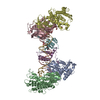
| ||||||||||
|---|---|---|---|---|---|---|---|---|---|---|---|
| 1 |
| ||||||||||
| Unit cell |
|
- Components
Components
| #1: Protein | Mass: 37811.238 Da / Num. of mol.: 4 Source method: isolated from a genetically manipulated source Source: (gene. exp.)  Strain: PCC 6803 / Kazusa / Gene: cas1, slr7016 / Production host:  References: UniProt: Q6ZEI2, Hydrolases; Acting on ester bonds #2: Protein | Mass: 11656.425 Da / Num. of mol.: 2 Source method: isolated from a genetically manipulated source Source: (gene. exp.)  Strain: PCC 6803 / Kazusa / Gene: cas2-1, ssr7017 / Production host:  References: UniProt: Q6ZEI1, Hydrolases; Acting on ester bonds #3: DNA chain | | Mass: 10960.986 Da / Num. of mol.: 1 / Source method: obtained synthetically / Source: (synth.) synthetic construct (others) #4: DNA chain | | Mass: 11064.108 Da / Num. of mol.: 1 / Source method: obtained synthetically / Source: (synth.) synthetic construct (others) #5: Water | ChemComp-HOH / | |
|---|
-Experimental details
-Experiment
| Experiment | Method:  X-RAY DIFFRACTION / Number of used crystals: 1 X-RAY DIFFRACTION / Number of used crystals: 1 |
|---|
- Sample preparation
Sample preparation
| Crystal | Density Matthews: 3.32 Å3/Da / Density % sol: 62.99 % |
|---|---|
| Crystal grow | Temperature: 293 K / Method: vapor diffusion, hanging drop Details: 30% MPD, 0.1 M imidazole pH 6.5, 0.2 M (NH4)2SO4, and 10% (w/v) PEG3350 |
-Data collection
| Diffraction | Mean temperature: 100 K / Serial crystal experiment: N |
|---|---|
| Diffraction source | Source:  SYNCHROTRON / Site: SYNCHROTRON / Site:  SSRF SSRF  / Beamline: BL19U1 / Wavelength: 0.9793 Å / Beamline: BL19U1 / Wavelength: 0.9793 Å |
| Detector | Type: DECTRIS PILATUS 6M / Detector: PIXEL / Date: May 10, 2018 |
| Radiation | Protocol: SINGLE WAVELENGTH / Monochromatic (M) / Laue (L): M / Scattering type: x-ray |
| Radiation wavelength | Wavelength: 0.9793 Å / Relative weight: 1 |
| Reflection | Resolution: 3.7→50 Å / Num. obs: 27252 / % possible obs: 99.4 % / Redundancy: 12.5 % / Biso Wilson estimate: 44.65 Å2 / CC1/2: 0.983 / Net I/σ(I): 11 |
| Reflection shell | Resolution: 3.7→3.79 Å / Num. unique obs: 1782 / CC1/2: 0.521 |
- Processing
Processing
| Software |
| |||||||||||||||||||||||||||||||||||||||||||||||||||||||||||||||
|---|---|---|---|---|---|---|---|---|---|---|---|---|---|---|---|---|---|---|---|---|---|---|---|---|---|---|---|---|---|---|---|---|---|---|---|---|---|---|---|---|---|---|---|---|---|---|---|---|---|---|---|---|---|---|---|---|---|---|---|---|---|---|---|---|
| Refinement | Method to determine structure:  MOLECULAR REPLACEMENT MOLECULAR REPLACEMENTStarting model: 1ZPW Resolution: 3.72→33.81 Å / SU ML: 0.4946 / Cross valid method: THROUGHOUT / σ(F): 1.34 / Phase error: 33.0009 Stereochemistry target values: GeoStd + Monomer Library + CDL v1.2
| |||||||||||||||||||||||||||||||||||||||||||||||||||||||||||||||
| Solvent computation | Shrinkage radii: 0.9 Å / VDW probe radii: 1.11 Å / Solvent model: FLAT BULK SOLVENT MODEL | |||||||||||||||||||||||||||||||||||||||||||||||||||||||||||||||
| Displacement parameters | Biso mean: 43.12 Å2 | |||||||||||||||||||||||||||||||||||||||||||||||||||||||||||||||
| Refinement step | Cycle: LAST / Resolution: 3.72→33.81 Å
| |||||||||||||||||||||||||||||||||||||||||||||||||||||||||||||||
| Refine LS restraints |
| |||||||||||||||||||||||||||||||||||||||||||||||||||||||||||||||
| LS refinement shell |
|
 Movie
Movie Controller
Controller






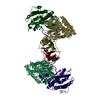
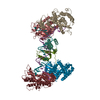
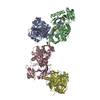
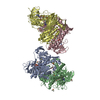

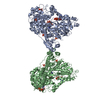
 PDBj
PDBj







































